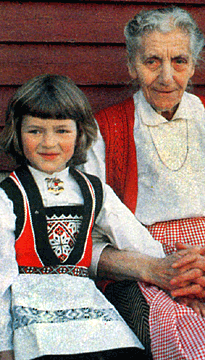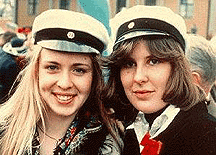Who
Are the Scandinavians?
by Bob Brooke
 What
characterizes the peoples of the North? The Danes, the Swedes, the
Norwegians, the Icelanders are the Scandinavian peoples–these are the
folk whom the racial anthropologists call Nordic. The men stand tall and
blond, the women fair. Nevertheless, the Nordic peoples rank high when
it comes to health, strength, endurance, size, intelligence, even
subjective beauty. What
characterizes the peoples of the North? The Danes, the Swedes, the
Norwegians, the Icelanders are the Scandinavian peoples–these are the
folk whom the racial anthropologists call Nordic. The men stand tall and
blond, the women fair. Nevertheless, the Nordic peoples rank high when
it comes to health, strength, endurance, size, intelligence, even
subjective beauty.
Originally the
Scandinavians–except for the Finns and the Lapps–must have been one
people. Perhaps their ancestors came northward from Asia Minor or the
Balkans and founded the great Teutonic family. As the last ice sheet
receded, small groups crept northward to hunt and fish and to settle.
Tribal differentiations developed, and by the Age of the Migrations,
beginning in the 2nd second century B.C., the Cimbri and the Goths, plus
the Angles, Saxons and Jutes, a few centuries later, mix with the Norse
Vikings. As late as 700 A.D., the runic inscriptions found in the three
central countries indicate that the people used exactly the same
language, but during the Viking period from 800-1100 A.D., a
consciousness of the oneness of Norway and of distinction between Danes
and Swedes grew.
Gradually environment
played its subtle part in selection and modification. Immigrating
groups--Scots, Walloons, Germans, and others–affected communities
differently. Variation in personalities and in experience changed habits
and traditions. Hence people and speech aren’t now the same in urban
Copenhagen, in the mining town of Kiruna in northern Sweden, and in the
rural valley of Setesdal in Norway.
Scandinavian
Languages
Books of one country can be more easily read in the other countries when
they’re translated, but translation is a matter of convenience rather
than necessity. Any Dane, Swede, or Norwegian can travel in the neighbor
countries, use his own speech, and be understood without too great
difficulty. In fact, these peoples don’t try to learn each other's
language, but at their various common gatherings each speaks his own,
with an occasional bow to some special idiosyncrasy of his neighbor.
Skane has been a Swedish province for about 300 years and it speaks and
writes Swedish. But it was long Danish territory and still has close
cultural and economic ties with Denmark.
The story is different
with Iceland, for the Icelanders, basically of Norwegian stock since the
Viking Age have retained their ancient speech. At least their language
is most closely akin to that of the ancient skalds or poets and
the saga-writers. Danish, Norwegian, and Swedish have succumbed to
modernization within themselves and to acceptance of a number of words
from German, French, and English. The Icelanders are proud to say that
they, like the Greeks, always have a word for it. Even for such an
invention as the radio the Icelanders utilized one of their own
root-words and called it utvarp or out-casting and for television
used the ancient sjon or sight, vision.
Language illustrates one
of the many ways in which continuity and originality blend, and
similarities and differences exist side by side.
 The Finns, related
culturally and geographically to their western neighbors, are of
different origin. Their ancestors moved westward in prehistoric times
across the Russian plains, then north into Estonia and Finland. Perhaps
their homeland was around the Caspian Sea or in the Ural Mountains.
Related tribes, still scattered along the Volga, might be the reason the
Hungarians probably originated from the same stock. The Finns, related
culturally and geographically to their western neighbors, are of
different origin. Their ancestors moved westward in prehistoric times
across the Russian plains, then north into Estonia and Finland. Perhaps
their homeland was around the Caspian Sea or in the Ural Mountains.
Related tribes, still scattered along the Volga, might be the reason the
Hungarians probably originated from the same stock.
The languages of these
groups are at least distantly related, and belong to a distinct
development, as do the peoples themselves, not Slavic, not Teutonic.
They’re all part of the separate Finno-Ugrian group. They’re tall,
blond, and virile, with broad cheekbones. When they moved across the
Gulf of Finland, they probably found settlements of Germanic peoples
already in their destined country. The Finns absorbed some of these
peoples, but the Swedish communities on the west and south coasts have
remained distinct in blood and speech. The Finns themselves have
retained definite tribal characteristics in several of the landskap
or provinces. Others have moved on and have spread into northern Sweden
and Norway and mixed to some extent with the Lapps. Still other related
peoples, the Karelians, have occupied sparsely the cold forest area east
of Finland, but their contact with the Finns is slight.
Within Finland a
self-conscious minority retains Swedish speech and customs, and the
Finnish and Swedish languages are equal before the law. These Swedes
have been for centuries officials and farmers and fishers and have clung
to their two coastal areas in west and south. Finland was converted to
Christianity from Sweden, and for 600 years was an integral part of the
Swedish state. The national culture is therefore strongly impregnated
with Swedish elements, now so thoroughly absorbed that they seem
indigenous.
The "pure Finns" developed a strong nationalistic consciousness in the 19th Century and, although the nationalist antagonism was and is directed primarily against Russia, the Swedish minority has also suffered from it occasionally. The Finnish element stands in an overwhelming majority and many
Swedo-Finns seek identification with the predominant group by adopting Finnish names. In intermarriage the tendency is toward
Finnicization. Early in the 20th Century something like 12 percent of the population was Swedish-speaking, but now the proportion has declined to about seven percent. The most solid remaining area of Swedish predominance within Finnish boundaries is the Aland Islands. In most situations there’s no conflict between the two different peoples, and together they make one of the proudest and most self-assertive nationalities in Europe.Life is difficult in the northern forests. Returns may seem meager to some; to the Finns they are enough. With a patient will and a strength which transcends the physical these people have through centuries of hardship and of war with their eastern neighbors hardened their courage, their sisu. They dislike to admit impossibility, their backs are broad and unbending. They love their land with the passion of generations who have suffered to conquer the woods and the swampland, and who can suffer for centuries still.
Sibelius' Finlandia is a mirror of the popular spirit–somber,
strong, intense protest. Their people have enjoyed a legal position
better than that of the American Indian, but in many ways their
situation is as cruel.
 As to the major peoples of the North, despite certain superficial differences they remain much alike–more than most of them wish to admit. In social customs and outlook on life they’re closer to each other than New Englanders to Southerners. In religion, all the Scandinavians once worshiped Odin and Thor together. They passed together from paganism to Christianity. Now they are Lutherans-better than 90 percent throughout the area, although the ties are weakening.
The legal systems come from common origins and are dominated by a common philosophy; many modern social laws are formulated in common. As to the major peoples of the North, despite certain superficial differences they remain much alike–more than most of them wish to admit. In social customs and outlook on life they’re closer to each other than New Englanders to Southerners. In religion, all the Scandinavians once worshiped Odin and Thor together. They passed together from paganism to Christianity. Now they are Lutherans-better than 90 percent throughout the area, although the ties are weakening.
The legal systems come from common origins and are dominated by a common philosophy; many modern social laws are formulated in common.
The basic common ideal of individualism is modified in practice by the varying degrees of socialism in each of the five states. Literacy is, for all practical purposes, 100 percent throughout, and nowhere in the world is there a higher per capita production and consumption of books. Freedom of expression is an ideal and a practice. Poverty is one of the few things "verboten," and great wealth is taxed with severity.
Perhaps the most obvious inherent characteristic of the Scandinavians is their pervasive practicality. They can dream, yes, but they’re likely to dream of worldly things. They’re scientists and technologists, architects and designers, shipbuilders and sailors, as well as skillful, resourceful administrators, long successful in the art of governing themselves.
Exceptions–Emanuel Swedenborg, Hans Christian Andersen, Edvard Grieg–are rare. Henrik Ibsen recognized and portrayed the inner conflict of man's spirit; in Peer Gynt fancy dominates reality, and often a Northerner likes to think he has a good bit of Peer Gynt in himself, though 99 percent of them suppress the little imp most effectively. Abstract thinking is rare, and a materialistic attitude toward life is deep rooted. A profound love of nature and of the physical is visible, expressing itself in literature and art, in competitive sports and hiking, bicycling, boating, and skiing in the high fields.
Essentially united as one family, but with strong intra-family differences, the Scandinavians prize unity, but revere their national traditions.
< Back to Article
Index |